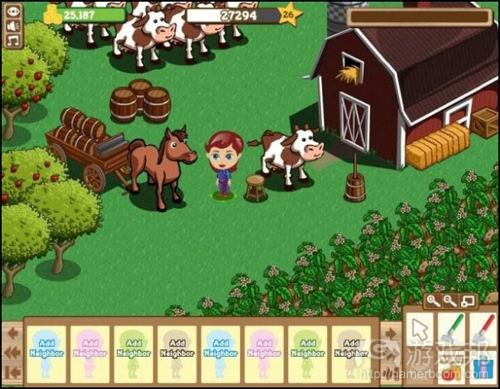社交游戏就设计理念而言称得上游戏吗?
之所以用这样一个富有争议的题目,是为了还吸引读者的注意,现在我们可以开始切入这个近来备受关注的争论。
这些所谓的社交游戏是什么呢?游戏或者多人竞争游戏不是具有社交性吗?多年来论坛和社区早已就遍布各地,游戏领域当然不乏交流工具。那么这些游戏同之前的游戏区别何在呢?
我认为要解答这个问题就得追溯到社交游戏的根源。社交游戏是迎合新兴市场的新游戏类型。由于社交网络(游戏邦注:如Orkut和Facebook)和社交圈的出现,用户开始同好友和虚拟陌生人汇集一堂。这给游戏公司提供了契机。用户如今已经能够聚集在一起,展开交流,游戏不过是继虚拟聊天室之后的又一发展。
很多人认为这些新游戏并非真正的游戏,它们并不是富有意义的体验,体验这些游戏的群体并非真正的玩家……
下面我们就从游戏的专业定义切入,这些应用具有情境,设有目标,具有风险/回报权衡,游戏含有角色,具有背景故事,它们从视觉、听觉角度再现现实世界。所以为何有人认为它们算不上游戏呢?
我们认为这些游戏的设计目标和传统游戏不同(游戏邦注:休闲游戏在制作方面和传统游戏尚有几分相似之处)。社交游戏设计师也许会问自己这样的问题:玩家要如何获得更多朋友以进行游戏体验呢?面对这个情况,社交游戏堪称一石二鸟之策,游戏既拥有核心设计策略,也融入强大营销工具。
社交游戏的趋势是玩家可以通过获得更多朋友推动游戏进程,消费真实金钱及连续体验游戏促使玩家不断回访查看劳动成果。所有这些机制都能够给游戏带来更大用户群,这正是游戏价值所在。如果开发商拥有庞大用户基础,游戏新增道具或宣传活动都有望带来更多营收。
传统游戏含有各式各样的机制,这些机制充当游戏前进的工具,辅助实现终极目标(游戏邦注:不论是杀死某个大头目,或者晋升至最终等级,抑或者是成为高分榜的第一名)。当然这些社交网络也有很多传统游戏,不过这些游戏注重高分排名,将玩家带入同好友直接竞争的状态。
这同时也改变了开发者设计这些应用的方式,他们依旧是游戏,只不过瞄准的是不同的群体。有利的一面是这些游戏的出现大大拓宽了市场,创造新机会。未来势必出现这些成功游戏的复制作品,但这和我们现在所看到的作品大同小异(想想第一款第一人称射击游戏或第一款即时战略游戏)。
这也许是最终结果,是新游戏类型的开端(游戏邦注:即“社交游戏”)。玩家也许会在数年之后意识到这点,那时社交游戏就会变成主流理念。这是新型游戏突破原有模式,同世人见面的必经之路。至于游戏娱乐价值是否因创收而受损,却并非本文要讨论的话题。(本文为游戏邦/gamerboom.com编译,如需转载请联系:游戏邦)
Game Design Tales
Social games against Game Design
Okey, I had to use a controversial title, now that I’ve got your attention we can settle down into what seems a common and recent debate.
What are these so called social games? Weren’t games or better yet, competitive multiplayer games already social? Forums and communities have been around for ages, there certainly wasn’t a lack of communication tools either. So what makes these games different from previous ones?
I believe that to answer this we need to look at the origin of it all. Social games are actually a new category that arose to cater an emergent market. Thanks to social sites like Orkut, Facebook and the entire sociosphere, people started gathering around friends or virtual personas. This created an opportunity for game companies to capitalize on. People were already gathered and communicating, games were just a logical step after virtual chatrooms.
There is a lot of heat everywhere saying that these new games are not actually games, that they are not meaningful enough, that the people playing them are not really gamers…
Wait a minute, what!?
If we go by the technical definition, these applications have a context, they have objectives, they have a risk/reward balance, they have a character, they may have a background story, they have a audiovisual representation of the world. So why would they call it non-games?
Playing with this idea a while in my head, I came to the conclusion that the design goals on these games have a different end-point than traditional games (even casual ones which are similar in terms of production). Game designers of these games are probably asking themselves, how do I get more friends to play the game? And with this simple fact, they kill two birds with one stone, they have a central design strategy as well as a really powerful marketing tool.
What the trend seems to be is that you can progress in the game by getting more friends, paying with real money or playing by bursts at a time forcing you to come back to see the fruits of your labor. Each one of these mechanics, if you will, end up working together to generate a big user base, which is where the value is. If you have a giant user base, each new item or promotion you introduce, could potentially generate lots of revenue.
Wrapping up, I promise.
Traditional games, have a range of mechanics that work as a tool to progress in the game, to reach a ultimate goal, be that slaying a big Boss, wandering into the last level or getting to the first place on the high-score ranking. Of course, there are a lot of traditional games on these social networks, but then they are mostly based on high-score rankings that put you in a direct competition with your friends.
This ends up shifting the way you design these applications, which are still games, that just seem to appeal to a different audience. The good thing is that this just opened the market, it created opportunities. Of course there were going to be clones of successful games, but that is not any different that we have already seen (Remember what happened with the first FPS? the first RTS?, the list goes on).
And that is basically the end result of all of this, the beginning of a new game genre, “Social Games”. It’s something that you may realize a few years later, when the concept has gone mainstream. And this is usually the case when something new, that breaks the mold, comes around. Whether the entertaining value decreases in favor of profit or not, that’s a subject for another debate.(Source:gamedesigntales)








































 闽公网安备35020302001549号
闽公网安备35020302001549号